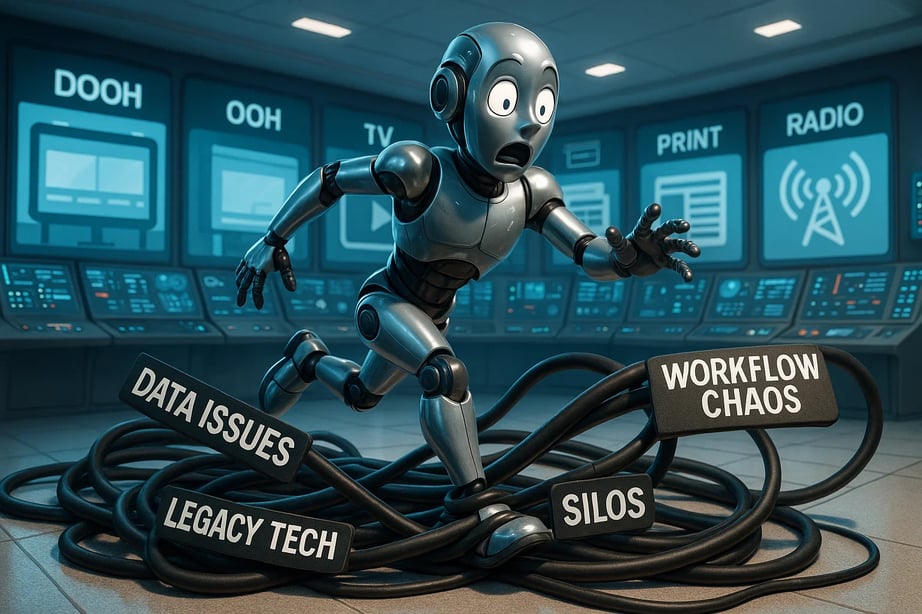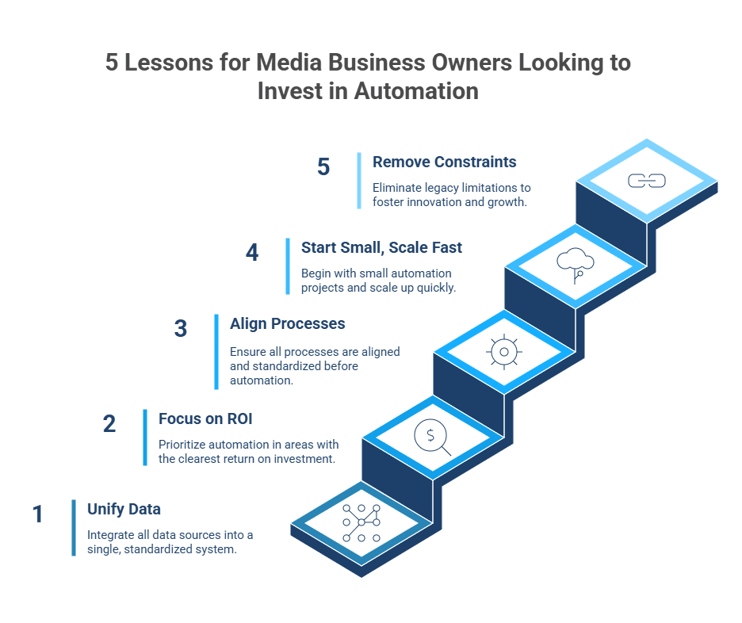What We Wish Every Media Business Owner Knew Before Investing in Automation?
Automation has always been the baseline for growth and survival for media businesses. But the concerning part is that many of these companies step into automation projects believing the technology alone will fix their operational chaos. Spoiler: it won’t.
Automation isn’t magic. It simply amplifies whatever foundation you already have. As Bill Gates once quoted,
“Automation applied to an inefficient operation will magnify the inefficiency.”

If your data and processes are not aligned, even the best-executed automation strategies won’t move the needle.
So, before you invest in automation platforms or partners, there are a few essential truths you deserve to know. Because the businesses winning today aren’t the ones with the most tools, they’re the ones with the clearest strategy.
Truth #1: Automation Only Works as Well as the Data Behind It
Many media businesses rush toward automation, expecting instant efficiency gains. However, they soon end up learning that their data isn’t ready for the leap. Inaccurate inventory availability, outdated rate cards, inconsistent campaign metadata, or disconnected trafficking systems can derail even the most advanced automation platforms.
Think about the dependencies:
- When your media assets aren’t mapped correctly…
- When your DOOH sites have mismatched IDs…
- When your print schedules differ by publisher…
- When your TV and radio logs aren’t synced with booking systems…
- When your Social metrics are not captured correctly…
Automation will only end up accelerating wrong outputs and wrong deliveries.
Put simply, clean, connected data isn’t an automation checkbox. It’s the backbone of revenue campaign performance and advertiser trust.
Key Takeaway: Before any automation initiative, you must unify and rationalise your data sources, standardise definitions, and establish a single source of truth.
Truth #2: Revenue Processes Deserve Automation Before Admin Work
It’s tempting to begin automation with low-risk, internal tasks like document creation or scheduling reminders. This is quite understandable. After all, they’re easier to tackle and wins feel quick. But here’s the catch: those improvements don’t fundamentally change your business outcomes.
The real value of automation in the media sector lies where money moves. When booking approvals are slow, inventory is double-sold, rate cards aren’t updated in real time, or billing errors keep revenue stuck in disputes, your business bleeds profit long before anyone notices.
From accurate spot placements in Social, TV and Radio to faster campaign execution in Print and OOH, revenue workflows should be the first priority. Automating these processes not only speeds up revenue cycles but also creates transparency that strengthens advertiser confidence.
Key Takeaway: Admin efficiencies are great. But they shouldn’t come at the cost of delayed cash flow and missed bookings. Put automation where ROI is clearest, and the rest of the org will naturally follow.
Truth #3: Automation Will Struggle to Scale if No Two Teams Work Alike
We’ve seen several media businesses operate on fragmented knowledge. One salesperson uses their own spreadsheet. Another negotiates custom pricing through email. The operations team follows a completely different playbook. All of this works only until you try to automate it.
Automation thrives on consistency. If workflows vary by team or even by individual, automation can’t standardise approvals, booking logic, pricing rules, or delivery checks. Instead, it amplifies the fragmentation. This can cause delays and frustrated teams reverting to old habits.
Though present in modern digital media channels like Social and Retail Media, this challenge is especially true in OOH and Print, where historical workflows differ wildly between markets and vendors. In radio and TV, legacy trafficking processes introduce even more exceptions. When everyone follows a different process, there is no single workflow to automate.
|
In a recent project with us at Brysa, a UK-based digital/OOH publisher was grappling with ad-trafficking chaos: their sales, creative, and operations teams all worked in different silos, creating inconsistent workflows and bottlenecks. We implemented a 24×7 MediaOps model with process-driven trafficking workflows, clear SLAs, real-time dashboards, and central coordination across teams. The result? A 75% reduction in error rates, fewer reworks, and faster campaign launches. |
Key Takeaway: Before technology enters the room, alignment must. Establish common processes and clear inputs. Then let automation bring the scale.
Truth #4: Transformation Works Best When It’s Built, and Iterated
Many media organisations jump into automation with a sweeping, all-at-once approach. It looks bold on a PowerPoint slide. “Full workflow transformation in one go.” But in reality? It often leads to rework and a scramble to fix issues that only surface once the system goes live.
Remember - media operations are interconnected. A change in rate cards impacts booking. A change in booking impacts scheduling. A change in scheduling impacts proof-of-performance and billing.
When one link breaks, the entire chain feels the shock. The businesses winning with automation follow a smarter playbook:
- Identify a high-impact use case
- Automate it end-to-end
- Test it with real business scenarios
- Roll out the next improvement based on learnings
This iterative approach improves adoption and allows teams to see the benefits as they go, not after a year of disruption.
Key Takeaway: Start small. Scale fast. Because the real transformation isn’t one giant launch. It’s a series of compounding wins.
Truth #5: Outdated, Disconnected Tech Becomes the Ceiling for Innovation
Across Social, Retail, OOH, Print, TV, and Radio, many core systems were never built for automation. There were old booking platforms, spreadsheets for inventory, fragmented CRM data, and siloed scheduling tools. They do the job, but they limit how far automation can go.
Legacy tech often creates invisible barriers:
- No real-time inventory updates. It results in double bookings and lost revenue
- No standardised client data. It leads to inconsistent reporting and billing disputes
- No API support. This means every improvement requires manual effort or custom patches
The results are not good. Automation projects get stuck trying to work around the past instead of building for the future.
This is where Salesforce changes the trajectory. Instead of patching legacy tools, Salesforce centralises customer, deal, and operational data into a connected ecosystem. With industry-specific modules and robust integrations, it gives media businesses a scalable platform where automation can actually run end-to-end. From proposal to billing to proof-of-performance, everything is covered.
Key Takeaway: Modern automation isn’t just about adding new tools. It’s about removing the old constraints that kept growth in check. When Salesforce becomes the source of truth, legacy limitations stop dictating what’s possible and innovation finally gets room to accelerate.

About Brysa
At Brysa, we’ve seen firsthand what happens when media companies try to scale on fragmented data, broken workflows, and legacy systems that simply weren’t built for today’s pace. As a leading Salesforce consulting partner for media businesses, we don’t just implement technology; we help you redesign the way revenue moves through your business. We build connected workflows that unlock faster deal cycles and stronger advertiser confidence. Remember - when the right strategy, right platform, and the right partner meet, innovation doesn’t get blocked by the past, it becomes your competitive edge. Get in touch with us to kickstart your Salesforce implementation.